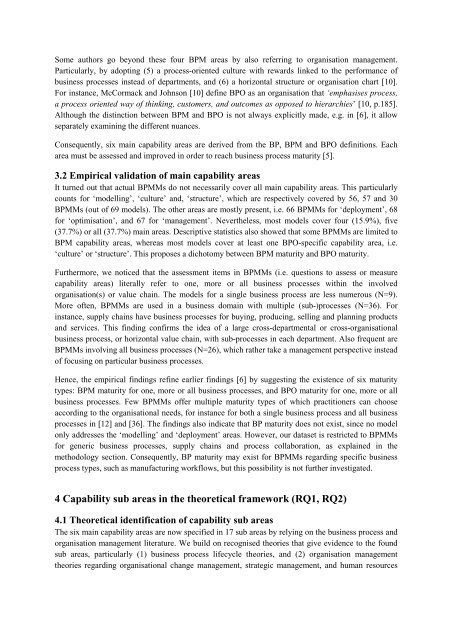A theoretical framework and classification of capability areas
A theoretical framework and classification of capability areas
A theoretical framework and classification of capability areas
Create successful ePaper yourself
Turn your PDF publications into a flip-book with our unique Google optimized e-Paper software.
Some authors go beyond these four BPM <strong>areas</strong> by also referring to organisation management.<br />
Particularly, by adopting (5) a process-oriented culture with rewards linked to the performance <strong>of</strong><br />
business processes instead <strong>of</strong> departments, <strong>and</strong> (6) a horizontal structure or organisation chart [10].<br />
For instance, McCormack <strong>and</strong> Johnson [10] define BPO as an organisation that ‘emphasises process,<br />
a process oriented way <strong>of</strong> thinking, customers, <strong>and</strong> outcomes as opposed to hierarchies’ [10, p.185].<br />
Although the distinction between BPM <strong>and</strong> BPO is not always explicitly made, e.g. in [6], it allow<br />
separately examining the different nuances.<br />
Consequently, six main <strong>capability</strong> <strong>areas</strong> are derived from the BP, BPM <strong>and</strong> BPO definitions. Each<br />
area must be assessed <strong>and</strong> improved in order to reach business process maturity [5].<br />
3.2 Empirical validation <strong>of</strong> main <strong>capability</strong> <strong>areas</strong><br />
It turned out that actual BPMMs do not necessarily cover all main <strong>capability</strong> <strong>areas</strong>. This particularly<br />
counts for ‘modelling’, ‘culture’ <strong>and</strong>, ‘structure’, which are respectively covered by 56, 57 <strong>and</strong> 30<br />
BPMMs (out <strong>of</strong> 69 models). The other <strong>areas</strong> are mostly present, i.e. 66 BPMMs for ‘deployment’, 68<br />
for ‘optimisation’, <strong>and</strong> 67 for ‘management’. Nevertheless, most models cover four (15.9%), five<br />
(37.7%) or all (37.7%) main <strong>areas</strong>. Descriptive statistics also showed that some BPMMs are limited to<br />
BPM <strong>capability</strong> <strong>areas</strong>, whereas most models cover at least one BPO-specific <strong>capability</strong> area, i.e.<br />
‘culture’ or ‘structure’. This proposes a dichotomy between BPM maturity <strong>and</strong> BPO maturity.<br />
Furthermore, we noticed that the assessment items in BPMMs (i.e. questions to assess or measure<br />
<strong>capability</strong> <strong>areas</strong>) literally refer to one, more or all business processes within the involved<br />
organisation(s) or value chain. The models for a single business process are less numerous (N=9).<br />
More <strong>of</strong>ten, BPMMs are used in a business domain with multiple (sub-)processes (N=36). For<br />
instance, supply chains have business processes for buying, producing, selling <strong>and</strong> planning products<br />
<strong>and</strong> services. This finding confirms the idea <strong>of</strong> a large cross-departmental or cross-organisational<br />
business process, or horizontal value chain, with sub-processes in each department. Also frequent are<br />
BPMMs involving all business processes (N=26), which rather take a management perspective instead<br />
<strong>of</strong> focusing on particular business processes.<br />
Hence, the empirical findings refine earlier findings [6] by suggesting the existence <strong>of</strong> six maturity<br />
types: BPM maturity for one, more or all business processes, <strong>and</strong> BPO maturity for one, more or all<br />
business processes. Few BPMMs <strong>of</strong>fer multiple maturity types <strong>of</strong> which practitioners can choose<br />
according to the organisational needs, for instance for both a single business process <strong>and</strong> all business<br />
processes in [12] <strong>and</strong> [36]. The findings also indicate that BP maturity does not exist, since no model<br />
only addresses the ‘modelling’ <strong>and</strong> ‘deployment’ <strong>areas</strong>. However, our dataset is restricted to BPMMs<br />
for generic business processes, supply chains <strong>and</strong> process collaboration, as explained in the<br />
methodology section. Consequently, BP maturity may exist for BPMMs regarding specific business<br />
process types, such as manufacturing workflows, but this possibility is not further investigated.<br />
4 Capability sub <strong>areas</strong> in the <strong>theoretical</strong> <strong>framework</strong> (RQ1, RQ2)<br />
4.1 Theoretical identification <strong>of</strong> <strong>capability</strong> sub <strong>areas</strong><br />
The six main <strong>capability</strong> <strong>areas</strong> are now specified in 17 sub <strong>areas</strong> by relying on the business process <strong>and</strong><br />
organisation management literature. We build on recognised theories that give evidence to the found<br />
sub <strong>areas</strong>, particularly (1) business process lifecycle theories, <strong>and</strong> (2) organisation management<br />
theories regarding organisational change management, strategic management, <strong>and</strong> human resources

















